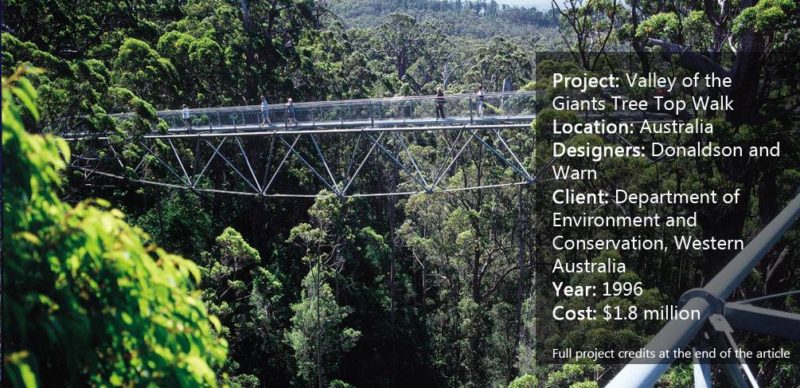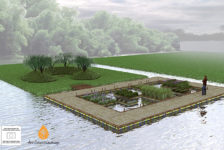Article by Win Phyo Valley of the Giants Tree Top Walk, by Donaldson and Warn, in Denmark and Walpole, Southern Ocean Coast of Western Australia. Do you know about the long-lost era of Gondwana? There is a unique piece of the Earth on the South Ocean Coast of Western Australia that provides a window to the past. To access this land, one must embark on a 600-meter-long Tree Top Walk, designed by Donaldson and Warn, which ventures among a grove of more than 400-year-old giants. One hundred and eighty million years ago, present-day South America, Africa, Arabia, Madagascar, India, Antarctica, and Australia comprised a supercontinent. Imagine this time of the Jurassic period, when the land was covered in lush rainforest and dinosaurs still roamed the Earth. The land in this part of Australia is a piece of this past, being home to one of the oldest groves of Eucalyptus trees — the tingle tree forest — where planting origins trace back as far as 65 million years ago.
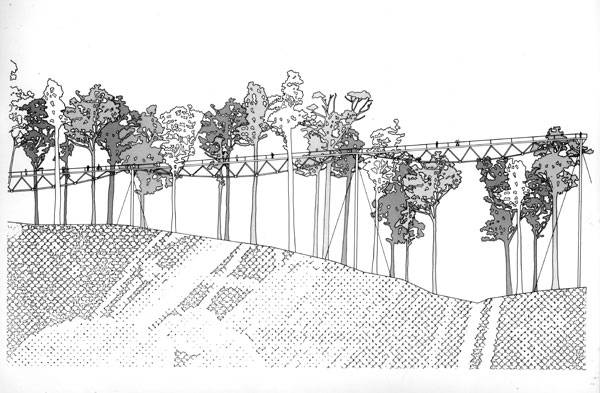
Valley of the Giants Tree Top Walk. Image courtesy of Donaldson and Warn
Valley of the Giants Tree Top Walk
Using no helicopters or cranes, construction to create the Tree Top Walk began in 1995 as a way to protect the forest. Visitors can enjoy the interpretive experience of fantasy, science, and awe by walking 40 meters high among trees that range in height from 40 meters to 80 meters in what we now call the Valley of the Giants. The simple design was the solution to a complicated context and matrix of challenges that were environmental, political, aesthetic, historical, and cultural in scope. How do you enhance a tourist destination that is home to some of the planet’s oldest trees while taking into account the above challenges?
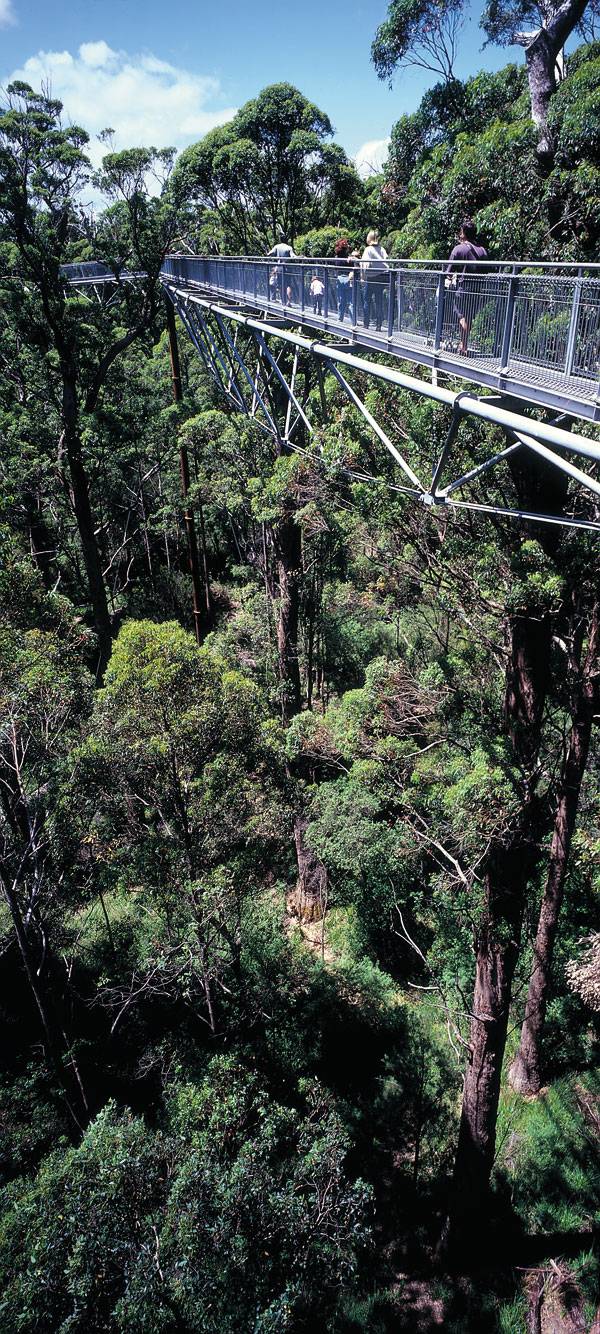
Valley of the Giants Tree Top Walk. Photo courtesy of Donaldson and Warn
In 1994, the increase of tourists visiting this destination made the sensitive eco-system present in the forest vulnerable to damage. The state government department, which was responsible for the management, wanted the designer to create an educational phenomenon that would attract more tourists, yet create minimal damage and produce a large economic return.
“The purpose of construction was to minimize the impact of humans on the tingle trees” The purpose of construction was to minimize the impact of humans on the tingle trees. It was important during construction that everything was built with minimum use of machines. No helicopters or cranes were used in the process; the work was done by riggers who used scaffolding — how impressive! Steel pylons were first erected, then stabilized by guy wires and topped by a circular lookout platform.
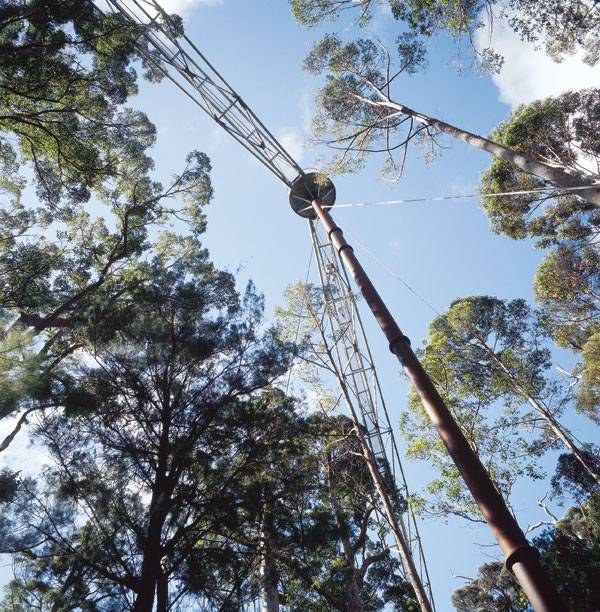
Valley of the Giants Tree Top Walk. Photo courtesy of Donaldson and Warn
Inspiration for the pylons came from the tassel flower (
Leucopogon verticillatus) and sword grass (
Lepidosperma effusum), which are understory plants of the tingle forest, with their slender, spreading forms. The pylons were made to oxidize over time, blending in to give a transparent aesthetic and sensation of swaying through the forest.
…allowing explorers to meander and look into the near and far distances… The pylons are linked by trusses, which support the boardwalk and are framed by metal balustrades. The result is a sensitive sculptural element within the landscape, weaving through the forest and allowing explorers to meander and look into the near and far distances.

Valley of the Giants Tree Top Walk. Photo courtesy of Donaldson and Warn
It is also encouraging to see that the disabled can also undertake such an experience, as the Tree Top Walk is wheelchair accessible.
Plant Life and the Climate Much of the plant life in this forest is unique to this region. For example, the tingle trees are restricted to a very small area around Denmark and Walpole, the two coastal towns in southwest Australia where there is a high annual rainfall of more than 1,200 millimeters. In contrast to other parts of Australia, the region has minimal impact from climate change and is characterized by well-drained, gravelly soil, a low nutrient content, and hilly terrain. As such, the forest is abundant with food sources for native animals and is also home to relict spiders and snails from Gondwanan times!
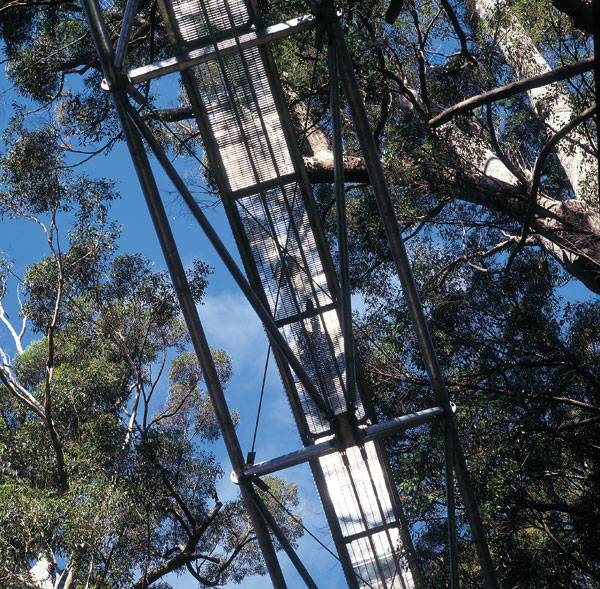
Valley of the Giants Tree Top Walk. Photo courtesy of Donaldson and Warn
Tree species include red tingle (
Eucalyptus jacksonii), yellow tingle (
Eucalyptus guilfoylei), marri
(Corymbia calophylla), and karri (
Eucalyptus diversicolor). These have a base circumference of up to 20 meters. The trees have a shallow root system and rely on surface humus for nutrients, making them vulnerable from people walking too close to the base.
..visitors are like birds – getting a bird’s eye view of the majestic trees, inspiring tranquility to the flock… It is very easy to be rendered speechless by the towering forest — walking this high up in the treetops is a different experience for visitors of Western Australia’s southern forests. Many of us are used to viewing things at about at least two meters above ground level. Here, visitors are like birds – getting a bird’s eye view of the majestic trees, inspiring tranquility to the flock.
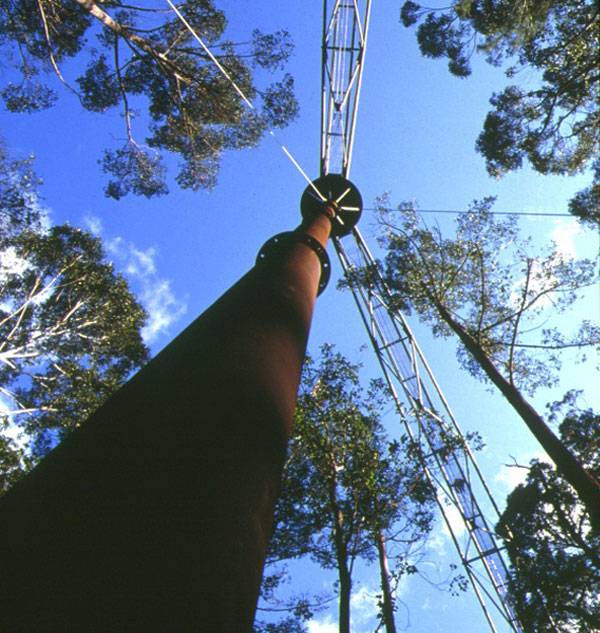
Valley of the Giants Tree Top Walk. Photo courtesy of Donaldson and Warn
The walkway is lightweight, allowing you to imagine yourself soaring above ground at your own pace. It is also a humbling experience to get to walk among some of nature’s giants, as the Tree Top Walk provides quiet spots to reflect on the special nature and unique ecosystem of the tingle forest. The journey is long enough to gain a different perspective on the shapes, sounds, and movement of the forest, as though the journey is a fantasy.
“The Valley of the Giants Tree Top Walk had attracted 2.1 million visitors by 2007” The Valley of the Giants Tree Top Walk had attracted 2.1 million visitors by 2007. Will future generations get the same chance to experience this destination? Let’s face it — all tourism projects have an impact on the environment of a place. However, the important role of an eco-tourism project is to educate visitors about reducing the impacts and fostering a greater appreciation of the natural habitats.
Other canopy walks around the world are constructed using a suspension bridge kind of structure, which we have all seen online and perhaps been lucky enough to experience, and they are not for the faint-hearted. The Tree Top Walk, however, has proved itself to be secure, even for
wheelchair access and the elderly. Perhaps now, the only question we can ask is whether you think the bridge structure is architecturally successful in resolving the environmental, political, aesthetic, historical, and cultural matrix of challenges? Let us know in the comments below! Go to comments 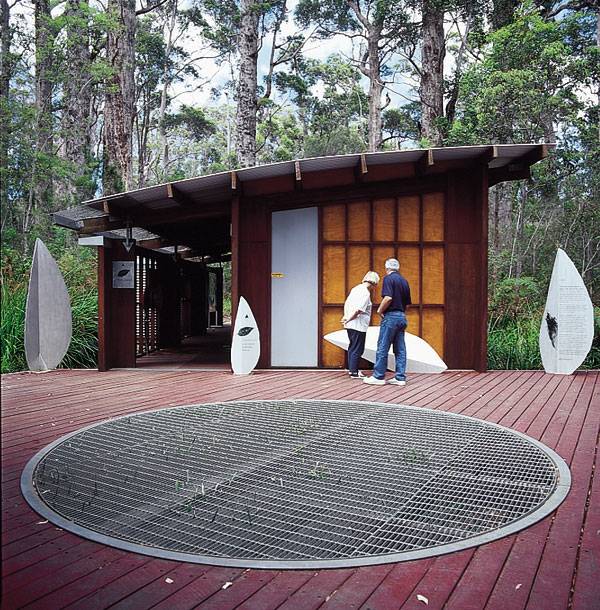
Valley of the Giants Tree Top Walk. Photo courtesy of Donaldson and Warn
Full Project Credits For The Valley of the Giants Tree Top Walk:
Project Name: Valley of the Giants Tree Top Walk Location: Denmark and Walpole, Southern Ocean Coast of Western Australia Designer: Donaldson and Warn Structural Engineers: Ove Arup Client: Department of Environment and Conservation, Western Australia Length of the Walk: 600 meters Height of the Walkway from the Forest Floor: 9 meters to 40 meters Construction Period: 1995- 1996 Cost: $1.8 million Learn more about Donaldson and Warn: Website: www.donaldsonandwarn.com.au Recommended Reading:
Article by Win Phyo Return to Homepage
Published in Blog








